Having thus been brought into the place of light the Candidate is given not the genuine secrets, but only substituted ones. This fact must often have puzzled the Candidate.
Chapter V – The Secrets
The practical reason given in the ritual, though perfectly intelligible to a Royal Arch mason (Companion) , cannot be the real one.
In view of the unexpected calamity no-one could have thought King Solomon was breaking his obligation by nominating a successor to Hiram Abiff and giving him the full secrets.
Actually, according to the Royal Arch story, he did something much worse, for he wrote them down and placed them somewhere, in the hopes that they would be subsequently rediscovered, and he had no assurance that their discoverers would even be masons, much less that they would keep their discovery secret.
Of course, this is also an allegory, and from this standpoint perfectly correct.
The lost secrets are the nature and attributes of God, which must be realised by each man for himself, and no other man can really communicate them.
Moreover, this complete realisation of the nature of God, and the union of the Divine Spark within us with the Source of All, can never be achieved during mortal life.
Even after death we shall need to leave the world long behind and travel far, before we can hope to attain that state of spiritual evolution which will enable us to approach the Holy of Holies, and gaze with unveiled eyes upon Him, Who is the beginning and the end of all.
With regard to these substituted secrets, let us note that they grow out of those used by the Fellowcraft.
Having already shown in the last book that the signs of the Fellowcraft, and in fact the real secrets of that degree, is the transformation of Jehovah into Jeheshue, we see that this is most appropriate.
To use modern language, the second degree teaches of the birth of the Christ Spirit within us, while the third indicates that mystically we, like the great Master, must die and rise again.
As St. Paul says, ” Die daily in Christ.”
The signs given are probably all of great antiquity. Of some we have evidence which shows that they were venerated in ancient Egypt and Mexico, are still employed in the primitive Initiatory Rites of the savages and are associated with the Gods in India.
For example, the penal sign is used by Shiva, the Great Destroyer, Who when He makes it, holds in His hand the lariat of death.
The sign of grief and destress is found all round the world, as I have shown in full detail in Sign Language of the Ancient Mysteries. Ancient Mexico, where Quetzalcoatl makes it, can be matched with Easter Island in the far Pacific, Peru, West Africa, East Africa, New Guinea, Malaya and many other places.
Major Sanderson points out that the second casual sign is depicted in Egyptian pictures as being used by those who are saluting Osiris in his coffin.
Those who desire will find it in Papyrus 9,908 in the British Museum.
The English sign of grief and destress (for up till now we have been speaking of the Scotch form) is almost certainly not the correct one. Its general appearance would incline one to believe that it is a penal sign, though whence derived it is difficult to say.
A little thought will indicate the nature of the penalty as being somewhat similar to that of one of the higher degrees.

The Raising of Lazarus, by Rembrandt. Oil on panel. c.1630-1632. Los Angeles County Museum of Art
IMAGE LINKED: wikimedia Attribution 4.0 International (CC BY 4.0)
So far as I can find it is not recognised as a sign of grief and destress to-day, except among masons who are descended Masonically from the Grand Lodge of England, but in a picture by Guercino of Christ cleansing the Temple, in the Palazzo Rosso, Crenoa, both this and the Scotch form are shown, while the G. of H. constantly appears in mediaeval paintings, e.g., in the Raising of Lazarus. [1]
The so-called Continental form undoubtedly comes from a well known high degree, where it is much more appropriate: it is apparently restricted to the Latin countries, whereas even in Germany it is the Scotch form that is employed.
The sign. of exultation is a form used to this day in of Asia to indicate worship, and was similarly employed in Ancient Egypt.
Major Sanderson suggests that it was copied from the position in which Shu upheld the sky.
Thus we see that six out of the so-called seven signs can be shown to be of ancient origin, and it is quite probable that further research will enable us to prove that the other one is equally old.
Such signs as these originally had a magical significance, and the explanation given in the ritual as to their origin is no doubt of a much later date than the signs themselves.
Indeed, a careful study of certain of the signs will show that they are not the natural signs which would have been used to indicate the feeling they are said to express.
For example, in the sign of horror the left hand would not naturally be placed in the position in which we are taught to put it, if this sign had originated as related in the story.
So obvious is this that some modern preceptors of Lodges of Instruction have to my knowledge altered the position of the left hand in order to make it conform to the story, but I venture to think that in so doing they are committing a very serious mistake, nothing less than the removal of an ancient landmark.
Some day we shall probably discover the real origin of this sign, but if it is altered that will of course become impossible.

Above: Lions Paw was given in the Pyramid Mysteries
Detail:Duncan’s Masoic Ritual and Monitor, by Malcom C. Duncan, [1866]
IMAGE LINKED: wikimedia Attribution 4.0 International (CC BY 4.0)
The lion’s grip and the actual position of raising are equally old, and, so far as we can find, this manner of raising is employed in every rite, whether ancient or primitive, which deals with the dramatic representation of death.
As a manner of greeting it is employed by the initiated men in many Red Indian Tribes, in West Africa, among the Senussi in North Africa, and in the Dervish Rites. [2]
The parts of the body brought in contact with each other are all parts presided over by some sign of the Zodiac, and there would appear to be some old astrological meaning which has now become lost.
It may possibly have been connected with Gemini, the Twins, and this fact is made the more probable by the survival of the name “The Lion’s Grip “.
The explanation given, although possibly of a fairly recent origin, nevertheless contains a valuable inner meaning, for it shows that we cannot hope to advance towards God unless we do our duty to our fellow men.
Thus, in dramatic form is shown that the brotherhood of man necessitates the Fatherhood of God.
It hardly seems necessary in this book to point out again that the regular step forms a tau cross and teaches us that we must trample under foot our animal passions, if we desire to approach near to God.
We note, however, that the Candidate, in advancing to obtain the secrets, has perforce to make three tau crosses, and the Christian Mystic will doubtless perceive in this a hidden reference to the three crosses on Calvary.
Finally, as has already been pointed out, the penalties of the first and second degrees draw attention to two important occult centres, and so also in this degree the Solar Plexus, the most important occult centre of all, is indicated, and since the object of every Mystic is to achieve the Beatific vision, the fact that the monks of Mt. Athos, near Salonica, do so by fixing their eye on this part, shows that there is a very special reason for the special form of the penal sign of the third degree.
[1] see “The Sign Language of the Mysteries” by Ward.
[2] For further explanation see “Who Was Hiram Abiff?” by Ward.
Article by: J. S. M. Ward
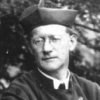
John Sebastian Marlow Ward (22 December 1885 – 1949) was an English author who published widely on the subject of Freemasonry and esotericism.
He was born in what is now Belize. In 1908 he graduated from the University of Cambridge with honours in history, following in the footsteps of his father, Herbert Ward who had also studied in history before entering the priesthood in the Anglican Church, as his father had done before him.
John Ward became a prolific and sometimes controversial writer on a wide variety of topics. He made contributions to the history of Freemasonry and other secret societies.
He was also a psychic medium or spiritualist, a prominent churchman and is still seen by some as a mystic and modern-day prophet.
Recent Articles: Master Mason's Handook J.S.M Ward

Book Review - The EA, FC, MM Handbooks
Essential reading for every Entered Apprentice, Fellowcraft, and Master Mason - these seminal books by J.S.M Ward are what every Mason needs!
more....
 The Master Mason's Handbook P1 Chapter 1 - Questions and Password; a brief explanation of the teaching of the third degree as contained in the symbols by J.S.M Ward |
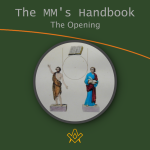 The Master Mason's Handbook P2 Chapter 2 - The Opening; a brief explanation of the teaching of the third degree as contained in the symbols by J.S.M Ward |
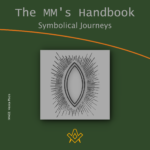 The Master Mason's Handbook P3 Chapter 3 - The Symbolical Journeys; We have seen in the previous books that the square and compasses are united on the pedestal in such a way as to form the Vesica Piscis, the emblem of the female principle, and the symbol of birth and rebirth. Hence symbolically the Candidate passes through the Vesica Piscis. |
 The Master Mason's Handbook P4 Chapter 4 - The Exhortation The opening part of the exhortation gives a convenient summary of the previous degrees and quite clearly indicates that the first inner meaning of the series is Birth, Life which is of course educational and preparatory for its sequel, and Death. |
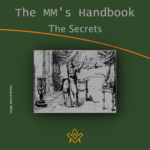 The Master Mason's Handbook P5 Chapter 5 - The Secrets. Having thus been brought into the place of light the Candidate is given not the genuine secrets, but only substituted ones. This fact must often have puzzled the Candidate. The practical reason given in the ritual, though perfectly intelligible to a Royal Arch mason (Companion) , cannot be the real one. |
 The Master Mason's Handbook P6 Chapter 6 - The Badge - On his re-entering the Lodge, the candidate is presented and in due course invested with the badge of a Master Mason by the S.W. The Badge itself, however, is full of symbolic meaning…. |
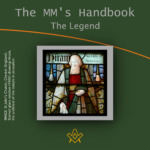 The Master Mason's Handbook P7 Chapter 7 - The Legend - After the ceremonial investiture of the Candidate the W.M. continues the narrative of the traditional history. At least this is the case in most English workings, but in some Scotch workings the whole story is told first, and subsequently the Candidate and the other brethren act the chief parts. Perhaps one of the most important points to realise is the correct meaning of the name Hiram Abiff . |
 The Master Mason's Handbook P8 Chapter 8 - The Tracing Board - The next part of the narrative is incorporated in most English workings with the Tracing Board. The most interesting feature is the description of the grave. It is obvious that peculiar stress is laid on the centre, even in the present form of our ritual, because of the way in which the measurements are given. |
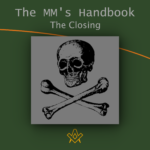 The Master Mason's Handbook P9/10 Chapters 9 & 10 The Closing Finally, even if a man can never fathom the full meaning of the third degree, yet there is no man worthy of the name who has passed through that third degree but will certainly have learnt one important lesson, namely, how to die, and thereby will be the better man. |
masonic knowledge
to be a better citizen of the world
share the square with two brothers

click image to open email app on mobile device







